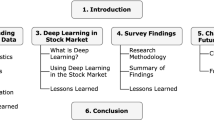Abstract
A topic of recent interest is risk management in equity investments from emerging markets. One traditional measure for systematic risk of an asset is beta, which is constructed through ordinary least squares (OLS) regression between historical returns on an individual asset and an index representing the overall market. OLS regression assumes all the error lies within the asset returns. Tofallis (Eur J Oper Res 187(3):1358–1367, 2008) made the case for constructing a systematic risk measure through symmetric regression, where error is assumed to be present in the returns of both the asset and the index. In this paper, we construct a systematic risk measure using symmetric regression for the case of the Johannesburg Stock Exchange (JSE). This paper makes the case that the so-called ‘total beta’ parameter provides a more realistic and stable estimator for market-related risk and return. The total beta estimate, explicitly allowing for error in both variables, is less likely to underestimate the magnitude of the beta parameter.




Similar content being viewed by others
Notes
In single-index model, such as the CAPM model, the idiosyncratic portion of firms’ returns are independent across firms. The diagonality assumption in a single-index model is that the errors between firms are not correlated.
While we have chosen the JSE in order to illustrate our work, this work is easily replicable for dichotomous markets such as the Australian and Canadian markets.
It should be noted that consecutive periods in longer time frame scenario have more data in common that consecutive periods in a shorter time frame scenario.
The specification of the structural break points of the financial crisis in South Africa are reflective of tests, the results of which were forwarded in a private communication.
References
Brown S (1989) The number of factors in security returns. J Financ 44(5):1247–1262
Camp R, Eubank A (1985) The beta quotient: a new measure of portfolio risk. J Portf Manag 7(4):53–57
Campbell G (1979) Risk and return on the Johannesburg stock exchange. Unpublished MBA thesis, Johannesburg: Department of Business Administration, University of the Witwatersrand
Conway DA, Reinganum MR (1988). Stable factors in security returns: Identification using cross-validation. J Bus Econ Stat 6(1):1–15
Damodaran A (2002) Investment valuation, 2nd edn. Wiley, Hoboken
Datastream (2014) Thomson Reuters Datastream. Available at: Subscription Service. Accessed Aug 2014
Dhrymes P, Friend I, Bultekin B (1984) A critical examination of the empirical evidence on the arbitrage pricing theory. J Financ 39:323–346
Draper N, Yang Y (1997) Generalization of the geometric mean functional relationship. Comput Stat Data Anal 23:355–372
Francis J (1979) Statistical analysis of risk surrogates for NYSE stocks. J Financ Quant Anal 14(05):981–997
Gilbertson B, Goldberg M (1981) The market model and the Johannesburg stock exchange. Invest Anal J 17:40–42
Kruger R (2004) A framework for evaluating the benchmark risk of South African equity portfolios. Unpublished MBusSci thesis, University of Cape Town, unpublished MBusSci thesis
Lintner J (1965) The valuation of risk assets and the selection of risky investments in stock portfolios and capital budgets. Rev Econ Stat 47(1):13–37
McElroy M, Burmeister E (1988) Arbitrage pricing theory as as restrictive nonlinear multivariate regression model. J Bus Econ Stat 6(1):29–42
Mossin J (1966) Equilibrium in a capital asset market. Econometrica 34(4):768–783
Nel W (2011) The application of the capital asset pricing model (CAPM): a South African perspective. Afr J Bus Manag 5(13):5336–5347
Noakes MA, Rajaratnam K (2014) Testing market efficiency on the johannesburg stock exchange using the overlapping serial test. Ann Oper Res 1–28. doi:10.1007/s10479-014-1751-y
Page M (1986) Empirical testing of the arbitrage pricing theory using data from the Johannesburg stock exchange. S Afr J Bus Manag 17(1):38–42
Page M (1989) Model selection for measuring security price performance. S Afr J Bus Manag 17(1):78–81
Ross S (1976) The arbitrage theory of capital asset pricing. J Econ Theory 13:341–360
Sharpe WF (1964) Capital asset prices: a theory of market equilibrium under conditions of risk. J Financ 19(3):425–442
Strugnell D, Gilbert E, Kruger R (2011) Beta, size and value effects on the JSE, 1994–2007. Invest Anal J 74:1–17
Tofallis C (2008) Investment volatility: a critique of standard beta estimation and a simple way forward. Eur J Oper Res 187(3):1358–1367
Tofallis C (2015) Fitting equations to data with the perfect correlation relationship. Hertfordshire business school working paper
van Rensburg P (2002) Market segmentation on the Johannesburg stock exchange II. J Stud Econ Econom 26(1):83–100
van Rensburg P, Robertson M (2003a) Size, price-to-earnings and beta on the JSE securities exchange. Invest Anal J 58:7–16
van Rensburg P, Slaney K (1997) Market segmentation on the Johannesburg stock exchange. J Stud Econ Econom 23(3):1–23
Ward M, Muller C (2012) Empirical testing of the CAPM on the JSE. Invest Anal J 76:1–12
Wisehart D (2010) Bostons battle of the beta. Financ Valuat Litig Expert 22:12–15
Acknowledgments
This work is based on the research supported in part by the National Research Foundation (NRF) of South Africa for the Grant No. 93649. Any opinion, finding and conclusion or recommendation expressed in this material is that of the authors, and the NRF does not accept any liability in this regard. Additional funding was provided by the NWU-DST-ABSA Risk Research Initiative.
Author information
Authors and Affiliations
Corresponding author
Appendices
Appendix A
Appendix B
Appendix C
Appendix D
Rights and permissions
About this article
Cite this article
Laird-Smith, J., Meyer, K. & Rajaratnam, K. A study of total beta specification through symmetric regression: the case of the Johannesburg Stock Exchange. Environ Syst Decis 36, 114–125 (2016). https://doi.org/10.1007/s10669-016-9596-3
Published:
Issue Date:
DOI: https://doi.org/10.1007/s10669-016-9596-3




